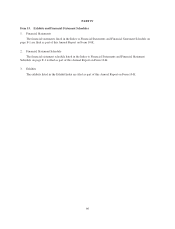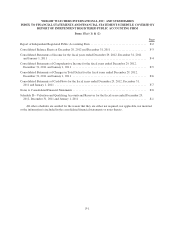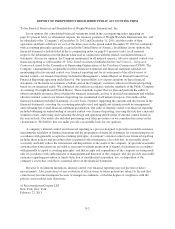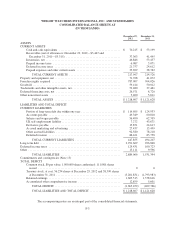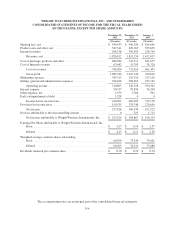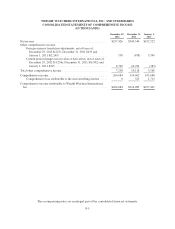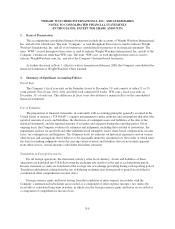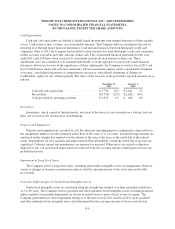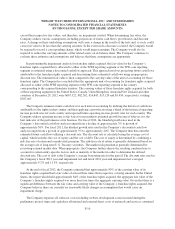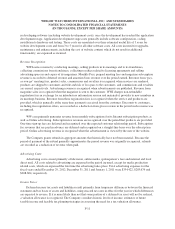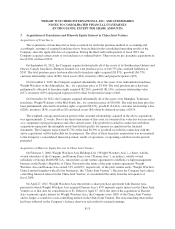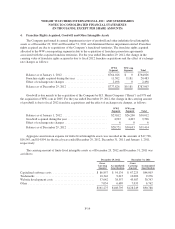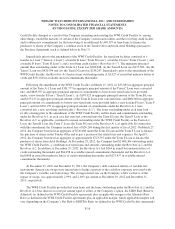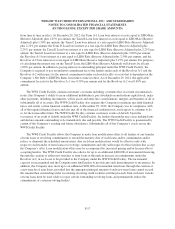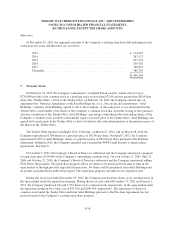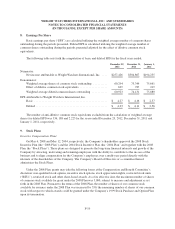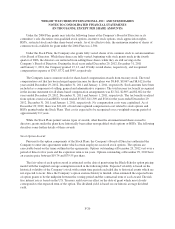WeightWatchers 2012 Annual Report Download - page 92
Download and view the complete annual report
Please find page 92 of the 2012 WeightWatchers annual report below. You can navigate through the pages in the report by either clicking on the pages listed below, or by using the keyword search tool below to find specific information within the annual report.WEIGHT WATCHERS INTERNATIONAL, INC. AND SUBSIDIARIES
NOTES TO CONSOLIDATED FINANCIAL STATEMENTS
(IN THOUSANDS, EXCEPT PER SHARE AMOUNTS)
exceed their respective fair values, and therefore, no impairment existed. When determining fair value, the
Company utilizes various assumptions, including projections of future cash flows, growth rates and discount
rates. A change in these underlying assumptions will cause a change in the results of the tests and, as such, could
cause fair value to be less than the carrying amounts. In the event such a decrease occurred, the Company would
be required to record a corresponding charge, which would impact earnings. The Company would also be
required to reduce the carrying amounts of the related assets on its balance sheet. The Company continues to
evaluate these estimates and assumptions and believes that these assumptions are appropriate.
In performing the impairment analysis for franchise rights acquired, the fair value for the Company’s
franchise rights acquired that is allocated to either of the WWI reporting segment or the WW.com reporting
segment is estimated using a discounted cash flow approach. This approach involves projecting future cash flows
attributable to the franchise rights acquired and discounting those estimated cash flows using an appropriate
discount rate. The estimated fair value is then compared to the carrying value of the unit of accounting for those
franchise rights. The Company has concluded that the appropriate unit of accounting for franchise rights acquired
allocated to either of the WWI reporting segment or the WW.com reporting segment is the country
corresponding to the acquired franchise territory. The carrying values of these franchise rights acquired for both
of these reporting segments in the United States, Canada, United Kingdom, Australia/New Zealand and other
countries at December 29, 2012 were $667,322, $82,262, $16,843, $15,124 and $5,456, respectively, totaling
$787,007.
The Company estimates future cash flows for each unit of accounting by utilizing the historical cash flows
attributable to the rights in that country and then applying a growth rate using a blend of the historical operating
income growth rates for such country and expected future operating income growth rates for such country. The
Company utilizes operating income as the basis for measuring its potential growth because it believes it is the
best indicator of the performance of its business. For fiscal 2012, the blended growth rates used in the
Company’s discounted cash flow analysis ranged from a decline of approximately 3% to growth of
approximately 50%. For fiscal 2011, the blended growth rates used in the Company’s discounted cash flow
analysis ranged from a growth of approximately 3% to approximately 20%. The Company then discounts the
estimated future cash flows utilizing a discount rate. The discount rate is calculated using the average cost of
capital, which includes the cost of equity and the cost of debt. The cost of equity is determined by combining a
risk-free rate of return and a market risk premium. The risk-free rate of return is generally determined based on
the average rate of long-term U.S. Treasury securities. The market risk premium is generally determined by
reviewing external market data. When appropriate, the Company further adjusts the resulting combined rate to
account for certain entity-specific factors such as maturity of the market in order to determine the utilized
discount rate. The cost of debt is the Company’s average borrowing rate for the period. The discount rates used in
the Company’s fiscal 2012 year-end impairment test and fiscal 2011 year-end impairment test averaged
approximately 9.2% and 11.3%, respectively.
At the end of fiscal 2012, the Company estimated that approximately 89% of the carrying value of its
franchise rights acquired had a fair value of at least three times their respective carrying amounts. In the United
States, the region which held approximately 84% of the franchise rights acquired, the aggregate fair value of the
Company’s franchise rights acquired was more than four times the aggregate carrying value. Given that there is a
significant difference between the fair value and carrying value of the Company’s franchise rights acquired, the
Company believes there are currently no reasonably likely changes in assumptions that would cause an
impairment charge.
The Company expenses all software costs (including website development costs) incurred during the
preliminary project stage and capitalizes all internal and external direct costs of materials and services consumed
F-10


